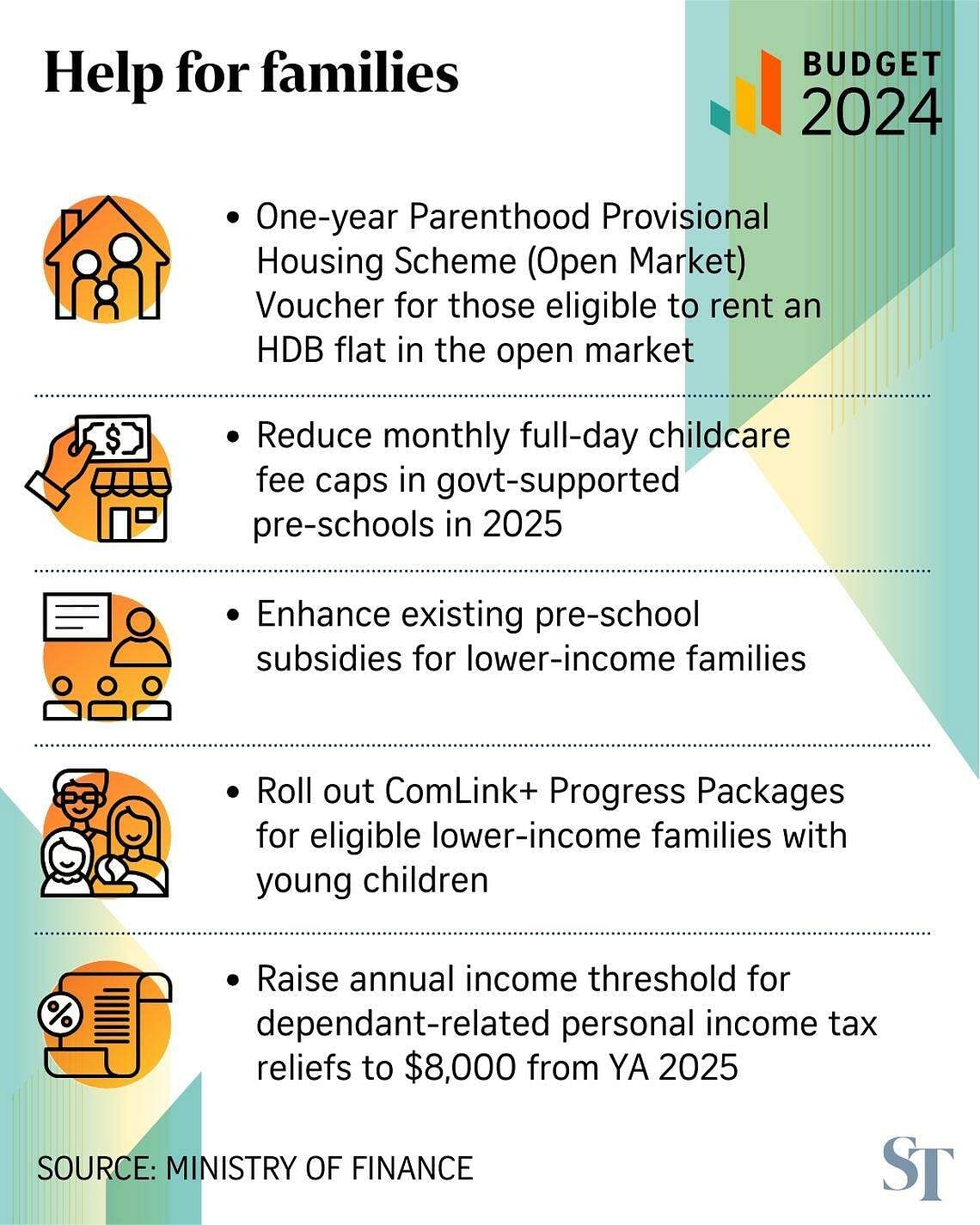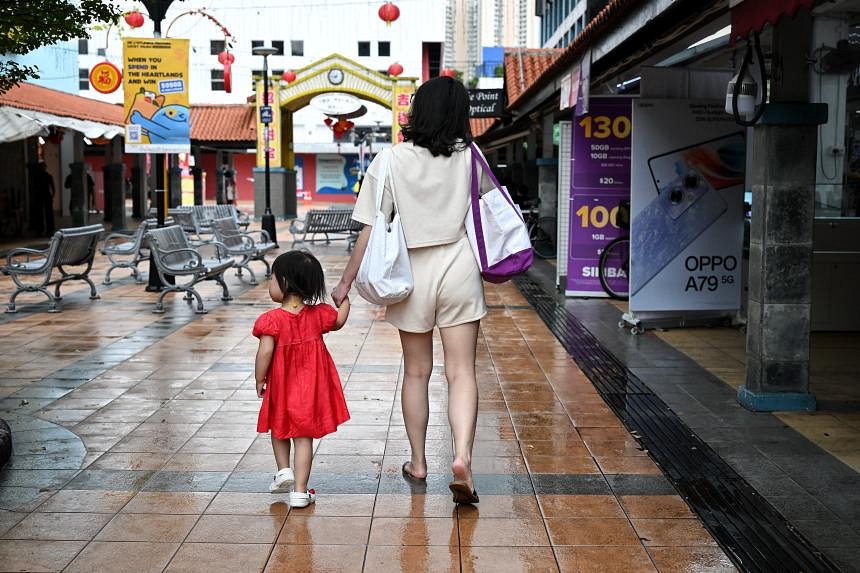The move to give non-working mothers from lower-income families higher childcare subsidies – which is currently for working mothers – is a significant policy shift.
Deputy Prime Minister Lawrence Wong said in his Budget 2024 speech on Feb 16 that this move will benefit up to 17,000 children.
It comes after years of MPs and non-governmental organisations calling for childcare subsidies for non-working mothers to be on a par with those for their working peers, as many of the lower-income mothers they see are unable to work due to caregiving duties, illness or other reasons.
And they say these families should not be penalised for the mother’s unemployment, especially when they need more help to send their children to pre-school, an important step in preparing for primary school.
Currently, mothers with Singaporean children get a monthly $300 basic subsidy if they are working. If they are not working, they get $150 a month in basic subsidy.
On top of that, working mothers get up to $467 a month in additional subsidy, which is means-tested. But non-working mothers do not get this extra subsidy.
That is set to change, as DPM Wong announced during the Budget that he will extend higher subsidies to all children from lower-income families, including those with non-working mothers.
DPM Wong said the monthly fee caps at government-supported pre-schools in 2025 will also be reduced to $640 for anchor operators and $680 for partner operators. The fees listed are the amounts before factoring in childcare subsidies.
Fee caps will be further reduced in 2026.
Anchor operators and partner operators receive government grants that help offset costs, such as staff salaries, in return for meeting fee caps and quality criteria.
DPM Wong said: “We will lower the fees further so that full-day pre-school expenses for dual-income families will be comparable to those of primary school and after-school student care.”
The Ministry of Social and Family Development will give more details on the changes during the debate on its budget in March.
According to previous media reports, the childcare subsidy was extended to non-working mothers from Jan 1, 2001. Before that, only working mothers received the subsidy.
Over the years, MPs such as Mr Louis Ng and former Nominated MP Anthea Ong have called for non-working mothers to receive the same amount of subsidies as working mums.
In the latest parliamentary question on the issue in January 2024, Non-Constituency MP Leong Mun Wai asked about the rationale for not giving non-working mothers the same level of subsidy as working mothers.
Minister for Social and Family Development Masagos Zulkifli replied that working mothers get more support as “they may have a greater need for care for their children while they are away at work”.
He said mothers who are not working due to extenuating circumstances, such as illness, caregiving responsibilities and those who are finding employment, and require full-day childcare, can apply for a special approval to get the same amount of subsidies as working mothers.
He added that low-income families living in highly subsidised Housing Board rental flats and those on the ComCare scheme are automatically eligible for the maximum pre-school subsidy, regardless of the mother’s employment status.

Boosting pre-school enrolment for children from lower-income families
So what factors could have led to the change this time round?
The Government’s recognition of the importance of pre-school education and the push to boost social mobility under the Forward Singapore exercise led by DPM Wong and his fourth-generation leadership team are the key drivers behind the change.
In the Forward Singapore report released in October 2023, it was stated that the proportion of children from lower-income families attending pre-school lags behind the national average.
Getting these children into pre-school from an early age is necessary to reduce the risk of their development lagging behind that of their peers when they enter Primary 1, said the report.
One of the four areas of support under the ComLink+ scheme that was announced in November 2023 is designed to encourage more low-income families to send their children to pre-school by the age of three.
For example, each child enrolled in pre-school will get a one-time $500 top-up to the Child Development Account (CDA) when he or she turns three. And those between the ages of three and six will get a $200 top-up to their CDA every three months if they attend pre-school regularly. The CDA is a special savings account for children that can be used to pay pre-school and healthcare fees.
During the Budget, DPM Wong described ComLink+ as a major innovation in Singapore’s social policy landscape.
Under ComLink+, low income families with children living in highly-subsidised HDB flats get financial incentives and other support if they take steps to improve their lives, such as getting a stable job that pays Central Provident Fund.
Helping lower-income kids level up
A large-scale study of 5,000 young children done here – known as the Singapore Longitudinal Early Development (SG Leads) study – found that a high-quality pre-school education helps to reduce substantial disparities in early childhood development between children from different socio-economic backgrounds.
Among other factors, such an education gives children from low-income families opportunities to interact with other children and adults who can help to boost their cognitive and social-emotional development, said Professor Jean Yeung, principal investigator of the SG Leads study. She is also the director of social sciences at the Agency for Science, Technology and Research’s Singapore Institute for Clinical Sciences.
One of the study’s findings published in 2023 showed that children aged between three and six with parents who are better educated or have a higher income tend to do significantly better when it comes to language and numeracy skills.
Others interviewed said the move to increase subsidies for non-working mothers acknowledges the difficulties many of these women face when it comes to employment.
For example, some have little qualifications, while others are foreigners who are limited by language and other constraints. These factors limit their job prospects and income, and so they may decide not to work as the cost of working outweighs their other considerations.
Some women need jobs with the flexibility to care for their young children and other family members, such as delivery gigs.
They may not clock enough hours of work to qualify for the working mother subsidy, said Associate Professor Sirene Lim, vice-dean of the S R Nathan School of Human Development at the Singapore University of Social Sciences.
She said many of the lower-income parents work in jobs that pay them a daily wage, and they are unable to work when their children fall ill. And young children tend to fall sick easily when they start going to pre-school, she added.
As Prof Yeung, who is also a professor at the National University of Singapore’s Yong Loo Lin School of Medicine, said: “It is a smart investment for society to help mothers in low-income families and to have their children attend pre-school because a child’s development in the very early years has important long-lasting consequences for development in adolescence and adulthood.”


